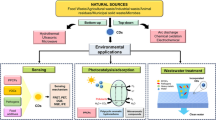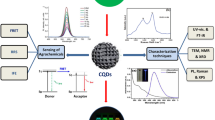Abstract
Textile dyes are considered micropollutants or emerging pollutants since they can be present in the environment at very low concentrations and show negative effects to human and environmental health. In this work, a luminol ECL inhibition sensor was successfully developed for detection of the textile dye Disperse Red 1 (DR1). Chitosan-Fe3O4 magnetic particles (MP) functionalized with luminol were mixed into a DR1 solution at different concentrations in the presence of H2O2. The mixture was dripped on the electrode surface, and measurements by linear sweep voltammetry and ECL were performed simultaneously. As a result, the ECL signal decreased with increasing DR1 concentration. This strategy exhibited good reproducibility and allowed us to determine DR1 at the very low detection limit of 0.070 pg mL−1. Also, there were good recoveries for detection of the textile dye in river water samples without the need of sample pretreatment. The ECL inhibition sensor has potential for application in the detection of a diversity of target molecules that could interact with luminol.

Graphical abstract






Similar content being viewed by others
References
Rasheed T, Bilal M, Nabeel F, Adeel M, Iqbal HMN (2019) Environmentally-related contaminants of high concern: potential sources and analytical modalities for detection, quantification, and treatment. Environ Int 122:52–66
Luo Y, Guo W, Ngo HH et al (2014) A review on the occurrence of micropollutants in the aquatic environment and their fate and removal during wastewater treatment. Sci Total Environ 473–474:619–641
Uliana CV, Garbellini GS, Yamanaka H (2013) Evaluation of the interactions of DNA with the textile dyes disperse orange 1 and disperse red 1 and their electrolysis products using an electrochemical biosensor. Sensors Actuators B Chem 178:627–635
Li L, Chen Y, Zhu J-J (2017) Recent advances in electrochemiluminescence analysis. Anal Chem 89(1):358–371
Bertoncello P, Forster RJ (2009) Nanostructured materials for electrochemiluminescence (ECL)-based detection methods: recent advances and future perspectives. Biosens Bioelectron 24(11):3191–3200
Valenti G, Fiorani A, Li H et al (2016) Essential role of electrode materials in electrochemiluminescence applications. ChemElectroChem 3:1990–1997
Valenti G, Rampazzo E, Kesarkar S et al (2018) Electrogenerated chemiluminescence from metal complexes-based nanoparticles for highly sensitive sensors applications. Coord Chem Rev 367:65–81
Hu L, Liu Z, Hu Y et al (2018) Fabrication of high-intensity electron transfer electrochemiluminescence interface for Hg 2+ detection by using reduced graphene oxide-Au nanoparticles nanocomposites and CdS quantum dots. J Electroanal Chem 823:397–406
Peng Y, Li Y, Li L, Zhu JJ (2018) A label-free aptasensor for ultrasensitive Pb2+ detection based on electrochemiluminescence resonance energy transfer between carbon nitride nanofibers and Ru(phen)32+. J Hazard Mater 359:121–128
Li C, Kang Q, Chen Y, Li J, Cai Q, Yao S (2010) Electrochemiluminescence of luminol on Ti/TiO2 NT electrode and its application for pentachlorophenol detection. Analyst 135(11):2806–2810
Liu Q, Huan J, Fei A, Mao H, Wang K (2015) “Signal on” electrochemiluminescence pentachlorophenol sensor based on luminol-MWCNTs@graphene oxide nanoribbons system. Talanta 134:448–452
Li X, Li J, Yin W, Zhang L (2014) Clopyralid detection by using a molecularly imprinted electrochemical luminescence sensor based on the “gate-controlled” effect. J Solid State Electrochem 18:1815–1822
Wu Y, Zheng Z, Yang J et al (2018) Bisphenol A electrochemiluminescence sensor based on reduced graphene oxide-Bi2ZnS4 nanocomposite. J Electroanal Chem 817:118–127
Liu X, Luo L, Li L et al (2019) An electrochemiluminescence aptasensor for analysis of bisphenol A based on carbon nanodots composite as co-reaction of Ru(bpy)32+ nanosheets. Electrochim Acta 319:849–858
Li Q, Tang W, Wang Y et al (2015) Electrochemiluminescence immunosensor for ketamine detection based on polyamidoamine-coated carbon dot film. J Solid State Electrochem 19:2973–2980
Xiong H, Gao J, Wang Y et al (2019) Construction of an ultrasensitive electrochemiluminescent aptasensor for ractopamine detection. Analyst 144:2550–2555
Adcock JL, Barrow CJ, Barnett NW, Conlan XA, Hogan CF, Francis PS (2011) Chemiluminescence and electrochemiluminescence detection of controlled drugs. Drug Test Anal 3(3):145–160
Zhang Z, Du P, Pu G et al (2019) Utilization and prospects of electrochemiluminescence for characterization, sensing, imaging and devices. Mater Chem Front 3:2246–2257
Liu Z, Qi W, Xu G (2015) Recent advances in electrochemiluminescence. Chem Soc Rev 44(10):3117–3142
Gross EM, Maddipati SS, Snyder SM (2016) A review of electrogenerated chemiluminescent biosensors for assays in biological matrices. Bioanalysis 8(19):2071–2089
Fang C, Li H, Yan J et al (2017) Progress of the electrochemiluminescence biosensing strategy for clinical diagnosis with luminol as the sensing probe. ChemElectroChem 4:1587–1593
Khoshfetrat SM, Bagheri H, Mehrgardi MA (2018) Visual electrochemiluminescence biosensing of aflatoxin M1 based on luminol-functionalized, silver nanoparticle-decorated graphene oxide. Biosens Bioelectron 100:382–388
Zhang X, Guo W, Wang Z et al (2017) A sandwich electrochemiluminescence immunosensor for highly sensitive detection of alpha fetal protein based on MoS2-PEI-Au nanocomposites and Au@BSA core/shell nanoparticles. Sensors Actuatos B Chem 253:470–477
Babamiri B, Bahari D, Salimi A (2019) Highly sensitive bioaffinity electrochemiluminescence sensors: recent advances and future directions. Biosens Bioelectron 142:111530
Tian X, Lian S, Zhao L et al (2014) A novel electrochemiluminescence glucose biosensor based on platinum nanoflowers/graphene oxide/glucose oxidase modified glassy carbon electrode. J Solid State Electrochem 18:2375–2382
Lin Y, Dai H, Xu G et al (2013) Enhanced luminol electrochemiluminescence triggered by an electrode functionalized with dendrimers modified with titanate nanotubes. Microchim Acta 180:563–572
Dai H, Wu X, Wang Y et al (2008) An electrochemiluminescent biosensor for vitamin C based on inhibition of luminol electrochemiluminescence on graphite/poly(methylmethacrylate) composite electrode. Electrochim Acta 53:5113–5117
Guo Z, Gai P, Hao T, Duan J, Wang S (2011) Determination of malachite green residues in fish using a highly sensitive electrochemiluminescence method combined with molecularly imprinted solid phase extraction. J Agric Food Chem 59(10):5257–5262
Wu MS, Sun XT, Zhu MJ, Chen HY, Xu JJ (2015) Mesoporous silica film-assisted amplified electrochemiluminescence for cancer cell detection. Chem Commun 51(74):14072–14075
Liu X, Fang C, Yan J, Li H, Tu Y (2018) A sensitive electrochemiluminescent biosensor based on AuNP-functionalized ITO for a label-free immunoassay of C-peptide. Bioelectrochemistry 123:211–218
Chumming J, Xiangqin L (2009) Electrochemical synthesis of Fe3O4-PB nanoparticles with core-shell structure and its electrocatalytic reduction toward H2O2. J Solid State Electrochem 13:1273–1278
Hu Y, Zhang Z, Zhang H et al (2012) Selective and sensitive molecularly imprinted sol-gel film-based electrochemical sensor combining mercaptoacetic acid-modified PbS nanoparticles with Fe3O4@Au-multi-walled carbon nanotubes-chitosan. J Solid State Electrochem 16:857–867
Yin H, Zhou Y, Liu T et al (2012) Determination aminopyrine in pharmaceutical formulations based on APTS-Fe3O4 nanoparticles modified glassy carbon electrode. J Solid State Electrochem 16:731–738
Wang Y, Zhang H, Yao D et al (2013) Direct electrochemistry of hemoglobin on graphene/Fe3O4 nanocomposite-modified glass carbon electrode and its sensitive detection for hydrogen peroxide. J Solid State Electrochem 17:881–887
Zhang W, Wang L, Zheng X (2014) Indicator-free electrochemical genosensing originated from the self-signal of poly-xanthurenic acid enhanced by Fe3O4/reduced graphene oxide. J Solid State Electrochem 18:2367–2373
Wang X, You Z, Sha H et al (2014) Electrochemical myoglobin biosensor based on carbon ionic liquid electrode modified with Fe3O4@SiO2 microsphere. J Solid State Electrochem 18:207–213
Uliana CV, Oliveira TR, Cominetti MR, Faria RC (2019) Label-free evaluation of small-molecule–protein interaction using magnetic capture and electrochemical detection. Anal Bioanal Chem 411(10):2111–2119
Rodrigues NFM, Neto SY, Luz RCS, Damos FS, Yamanaka H et al (2018) Ultrasensitive determination of malathion using acetylcholinesterase immobilized on chitosan-functionalized magnetic iron nanoparticles. Biosensors 8:16–28
Venturini Uliana C, Yamanaka H (2020) Immunosensor for detection of the textile dye disperse Orange 1 based on non-conventional competitive assay. Electroanalysis 32:70–75
Marquette CA, Blum LJ (2008) Electro-chemiluminescent biosensing. Anal Bioanal Chem 390(1):155–168
Sakura S (1992) Electrochemiluminescence of hydrogen peroxide-luminol at a carbon electrode. Anal Chim Acta 262:49–57
Yildiz G, Tasdoven U, Menek N (2014) Electrochemical characterization of luminol and its determination in real samples. Anal Methods 6:7809–7813
Uliana CV, Garbellini GS, Yamanaka H (2012) Spectrophotometric evaluation of the behavior of disperse red 1 dye in aqueous media and its interaction with calf thymus ds-DNA. J Braz Chem Soc 23:1469–1475
Leite LS, Maselli BS, Umbuzeiro GA, Nogueira RFP (2016) Monitoring ecotoxicity of disperse red 1 dye during photo-Fenton degradation. Chemosphere 148:511–517
Zocolo GJ, Santos GP, Vendemiatti J et al (2015) Using SPE-LC-ESI-MS/MS analysis to assess disperse dyes in environmental water samples. J Chromatogr Sci 53(8):1257–1264
Rocha CG, Ferreira AAP, Yamanaka H (2016) Label-free impedimetric immunosensor for detection of the textile azo dye disperse red 1 in treated water. Sensors Actuators B Chem 236:52–59
Choudhury AKR (2017) Sustainable chemical technologies for textile production. In: Muthu S (ed) Sustainable Fibres and textiles. Woodhead Publishing, Cambridge, pp 267–322
Khan P, Idrees D, Moxley MA, Corbett JA, Ahmad F, von Figura G, Sly WS, Waheed A, Hassan MI (2014) Luminol-based chemiluminescent signals: clinical and non-clinical application and future uses. Appl Biochem Biotechnol 173(2):333–355
Jing W, Lü S, Li X et al (2011) Determination of melamine in dairy products and melamine tableware by inhibition electrochemiluminescent method. Chin J Chem 29:1601–1605
Bandara HMD, Burdette SC (2012) Photoisomerization in different classes of azobenzene. Chem Soc Rev 41(5):1809–1825
Funding
The authors are grateful for the financial support provided by the National Council for Scientific and Technological Development (Proc. CNPq 465571/2014-0), São Paulo Research Foundation (Proc. FAPESP 2014/50945-4) and Coordination for the Improvement of Higher Education Personnel (Proc. CAPES 88887136426/2017/00).
Author information
Authors and Affiliations
Corresponding author
Additional information
Publisher’s note
Springer Nature remains neutral with regard to jurisdictional claims in published maps and institutional affiliations.
Rights and permissions
About this article
Cite this article
Uliana, C.V., Yamanaka, H. Simple, fast, and ultrasensitive method for textile dye determination based on luminol electrochemiluminescence (ECL) inhibition. J Solid State Electrochem 24, 1927–1933 (2020). https://doi.org/10.1007/s10008-020-04571-9
Received:
Revised:
Accepted:
Published:
Issue Date:
DOI: https://doi.org/10.1007/s10008-020-04571-9




